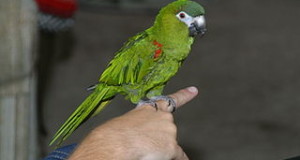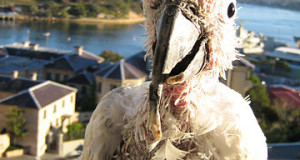Today we’ll take a look at some of the finer points (as opposed to the basics) involved in feeding canaries, doves, budgerigars, toucans and related birds. Please see Part I and Part II of this article for information on African Gray and Amazon Parrots, Mynas and Macaws.
Finches
The perception of finches as “seed-eaters” is at the root of poor feeding practices in captivity. Wild finches eat a wide range of foods…in most habitats, plants produce seeds only at certain times, not year-round. Outside of these times, birds must rely upon sprouts, insects and other foods.
Depending upon the species, pet finches should be offered a variety of live and canned insects, fruit, sprouts, egg food, pellets and finely chopped greens (endive, kale, escarole, etc.) on a daily basis.
Canaries
The points mentioned above apply also to that most popular of all finches, the Canary.
Red factor canaries (those with red-tinged feathers) present a special challenge. Interestingly, these birds are not true canaries but rather hybrids that arose when aviculturists crossed canaries with a finch known as the Venezuelan Black-hooded Red Siskin. The amount of red they exhibit is, therefore, influenced by genetics. However, color-promoting foods will help in maintaining red plumage.
Budgerigars (Parakeets) and Cockatiels
These small parrots are prone to obesity and fatty liver disease when fed seed-only diets, especially if they select only a few favored types of seeds. Budgerigars in particular are extremely stubborn when it comes to accepting pellets.
You might try offering pellets in the morning, when the birds are very hungry, and withholding seed until late afternoon. Lafeber Nutri-berries combine pellets with seeds and other tasty foods, and are an excellent way of weaning all types of parrots onto a healthier diet. Groups of budgerigars are more likely to try pellets than are individual birds – like children, they seem spurred to see what they are missing if one individual samples a new food!
Pigeons and Doves
Much like finches, pigeons and doves are often fed seeds and little else in captivity. In actuality, however, most take a wide variety of foods in the wild. Depending  upon the species, pigeons and doves should be provided with pellets, whole wheat bread, chopped kale and other greens and fruit. Freeze dried fruits are very useful for those keeping fruit doves and tropical species such as the Bleeding Heart Pigeon.
upon the species, pigeons and doves should be provided with pellets, whole wheat bread, chopped kale and other greens and fruit. Freeze dried fruits are very useful for those keeping fruit doves and tropical species such as the Bleeding Heart Pigeon.
Pigeons and doves are prone to calcium deficiencies in captivity…calcium enriched grit or crumbled oyster and egg shell should always be available. Birds with chicks require additional protein…nearly all accept egg food and some will take live and canned insects as well.
Toucans and Toucanets
Dietary variety is the key to keeping these entertaining beauties in peak condition. Care must also be taken that they do not select only a few favored fruits from their daily salad.
In addition to a nutritious softbill pellet, toucans and related birds should be fed a wide variety of fresh and freeze dried fruits, chopped vegetables (i.e. carrots, swiss chard, kale,), live and canned insects and an occasional pink mouse.
Toucans and toucanets are prone to Hemochromatosis, or iron-storage disease. Please see the article referenced below for further information.
Further Reading
A diet high in citrus fruit may be problematical for some species. Please see my article Iron Storage Disease for more information.
 That Bird Blog – Bird Care and History for Pet Birds
That Bird Blog – Bird Care and History for Pet Birds



